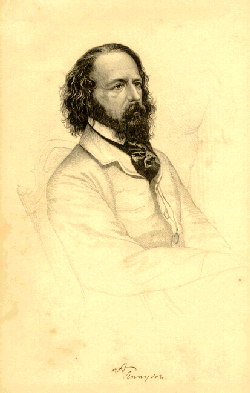Babbage and Tennyson
Today, Charles Babbage writes a letter to Alfred Lord Tennyson. The University of Houston's College of Engineering presents this series about the machines that make our civilization run, and the people whose ingenuity created them.
The English mathematician Charles Babbage, who conceived programmable computation, wrote to the young poet Tennyson. "In your otherwise beautiful poem," he said, "one verse reads,
Every moment dies a man,
Every moment one is born.
" ... If this were true," he went on, "the population of the world would be at a standstill. In truth, the rate of birth is slightly in excess of that of death. I would suggest [that the next edition of your poem should read]:"
Every moment dies a man,
Every moment 1 1/16 is born.
"Strictly speaking," Babbage added, "the actual figure is so long I cannot get it into a line, but I believe the figure 1 1/16 will be sufficiently accurate for poetry."
Babbage is obviously pulling Tennyson's leg. But his jab brings to light the peculiar good-humored relation between early-19th-century science and the new force of Romantic Poetry.
Tennyson turns up again in an 1844 letter from Elizabeth Barrett to Robert Browning. Someone has criticized Tennyson's poetry, and Barrett is annoyed. She says,
That such a poet should submit blindly to the suggestions of his critics is ... as if Babbage were to take my opinion & undo his calculating machine by it.
So Barrett and Browning were as aware of Babbage's work as he was of contemporary poetry. Of course I strongly doubt that Barrett ever knew Babbage had called on Tennyson to weave Malthusian population dynamics into his poetry.
Today we look back at Babbage and imagine a lonely genius, unknown in his time. That's a laugh. Not only was he at the center of English intellectual life, but his work on a seemingly intelligent machine touched nerves in those circles. It's no accident that his chief public spokesman was Ada Byron, daughter of the poet Lord Byron.
That may seem an odd alliance, but early-19th-century poets had formed a new vision of the mind's capacity. "We create nature by dreaming nature," they said. Babbage's computer -- his man-made mind -- was in perfect resonance with that vision.
Of course we couldn't fulfill the vision until after we had the transistor. The vision had to wait until the 1960s. By then science had built itself a house apart from poets. Still, that cool blue screen is there on your desk just because science and poetry fed upon each other 170 years ago.
So you mind-meld with your PC -- that flickering second self. Well, that subtle and complex little box traces straight back to the early-19th-century poetic agenda.
I'm John Lienhard, at the University of Houston, where we're interested in the way inventive minds work.
(Theme music)
Hyman, A., Charles Babbage: Pioneer of the Computer. Princeton, NJ: Princeton University Press, 1982.
Bernstein, J., The Analytical Engines: Computers, Past, Present, and Future. New York: Random House, 1964.

From Poems of Imagination and Fancy, 1891
Alfred Lord Tennyson